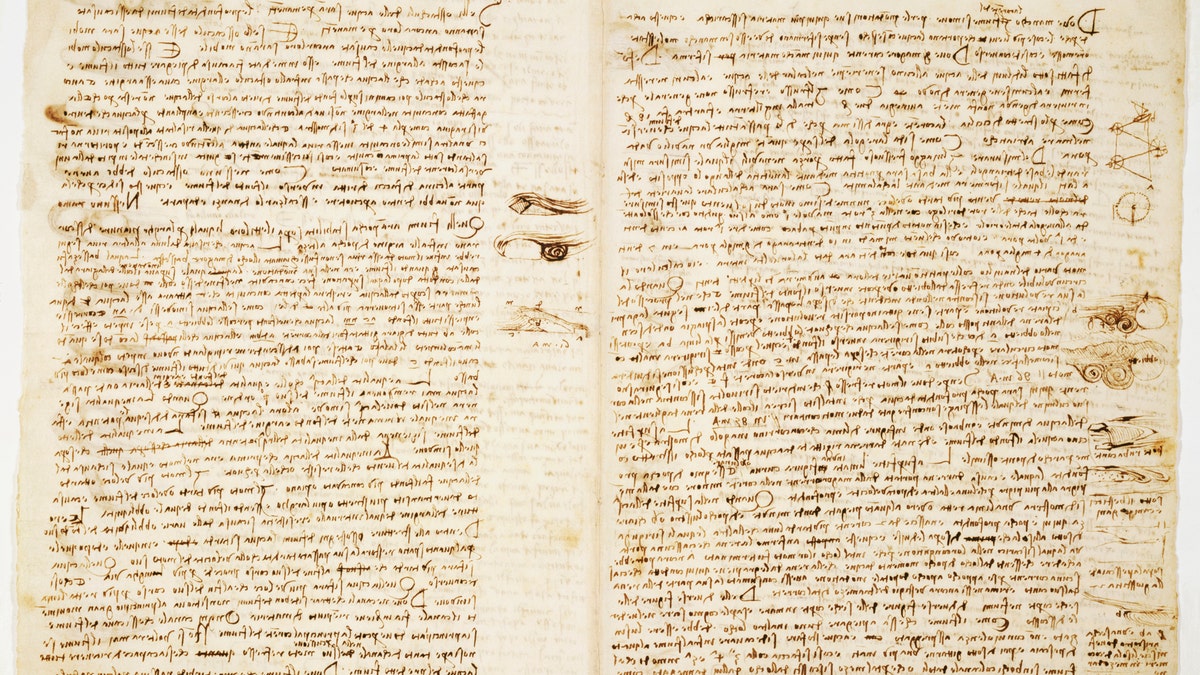
Sketch of Italian polymath Leonardo da Vinci/a sheet of the Codex Leicester. (Photo by Mansell/The LIFE Picture Collection/Photo by Seth Joel/Corbis/VCG via Getty Images)
The British Library in London is set to showcase a number of Leonardo da Vinci's most important notebooks, all written in his famous “mirror-writing.”
The "Leonardo da Vinci: A Mind in Motion" exhibit will include notes and drawings from three of his most revered scientific and artistic notebooks, the Codex Arundel, the Codex Forster and the Codex Leicester.
“These remarkable pages, written in Leonardo’s distinctive mirror writing, illustrate how his detailed studies of natural phenomena – and in particular of water – influenced his work both as an artist and an inventor,” explained the British Library, in a statement.
LEONARDO DA VINCI'S EARLIEST WORK DISCOVERED?
In addition to using his own shorthand, da Vinci also wrote his personal notes starting on the right-hand side of the page. It is not clear whether this so-called mirror writing was a way to keep his notes private or simply a means to prevent smudging, as da Vinci was left-handed.

File photo - Sheet discussing how to read water for navigation from Leonardo da Vinci's Codex Leicester (Photo by Seth Joel/Corbis/VCG via Getty Images)
Another famous southpaw, Microsoft co-founder Bill Gates, bought the Codex Leicester, for $31 million in 1994. The Codex, a 72-page collection of notes, is widely considered to be one of Leonardo’s most important scientific notebooks, according to the British Library.
The British Library exhibition, scheduled for next year, will mark the 500th anniversary of the Renaissance master’s death.
LEONARDO DA VINCI'S $450 MILLION 'SALVATOR MUNDI' PAINTING HEADS TO THE LOUVRE ABU DHABI
The library said Tuesday it will mark the first time selections from the three will be displayed together in Britain. The Codex Leicester is also being shown in the U.K. for the first time since its purchase by Gates.

Sketch of Italian polymath Leonardo da Vinci (1452 - 1519). (Photo by Mansell/The LIFE Picture Collection)
Curator Andrea Clarke said da Vinci's notebooks "show him to be an extraordinarily dynamic thinker who was able to make connections between multiple phenomena and disciplines."
The da Vinci exhibit will run from June until September.
HISTORIANS SAY THEY'VE FOUND LEONARDO DA VINCI'S LIVING RELATIVES
Da Vinci continues to be a source of fascination. Earlier this year, experts in Italy said they had found the earliest surviving work by da Vinci. The small glazed terracotta tile, described as a self-portrait of the artist as the Archangel Gabriel, was unveiled at a press conference in Rome.
However, the tile’s authenticity was questioned by noted Leonardo expert Martin Kemp, professor emeritus of the history of art at the University of Oxford.
There has even been some debate about the authenticity of Da Vinci’s “Salvator Mundi” painting, which sold for a record $450.3 million last year.
The painting grabbed headlines around the world when it was sold at Christie’s auction house in New York. "Salvator Mundi," Latin for "Savior of the World,” is one of fewer than 20 paintings by da Vinci known to exist and the only one in private hands.
The Associated Press contributed to this article. Follow James Rogers on Twitter @jamesjrogers




















